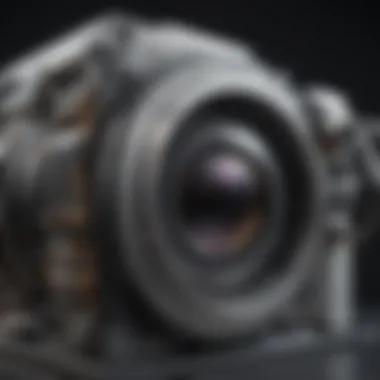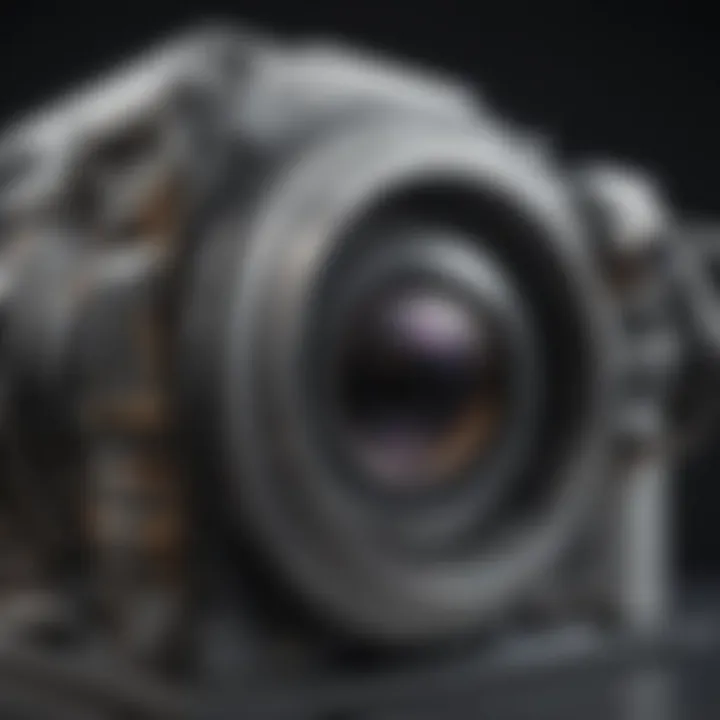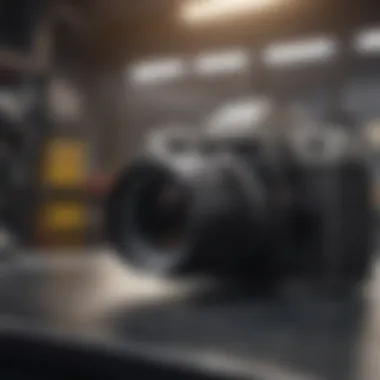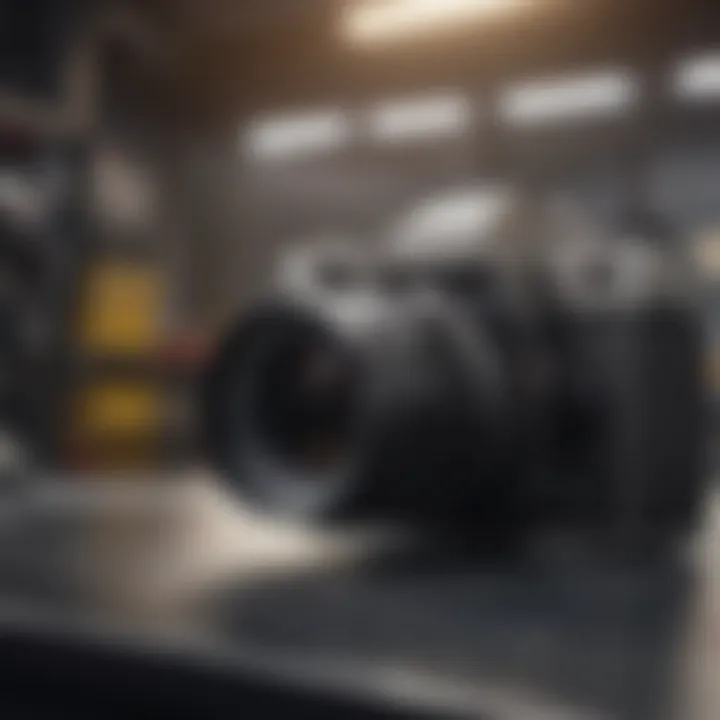Exploring Super High-Speed Cameras and Their Applications


Intro
Super high-speed cameras represent a remarkable convergence of technology and scientific inquiry. Their capability to capture fast-moving events at exceptionally high frame rates is a tool that transcends the typical limits of human perception. From industry to research, these cameras serve multiple applications, shedding light on phenomena that would usually escape our notice. Understanding their inner workings and potential benefits can open new avenues for research and innovation.
Methodology
Overview of Research Methods Used
In approaching the study of super high-speed cameras, various qualitative and quantitative research methods are applied. Key industry reports, technical publications, and academic articles provide foundational knowledge. In particular, interviews with engineers and technicians involved in high-speed imaging offer invaluable insights into both the theory and practical considerations of camera design and operation.
Data Collection Techniques
Data is primarily collected through:
- Literature Review: The examination of existing literature on high-speed cameras helps identify prevailing trends and technological developments.
- Case Studies: Real-world applications serve as critical examples to illustrate how these devices are employed in varied fields.
- Expert Interviews: Engaging with professionals in the field provides a deeper understanding of practical challenges and solutions.
Technological Advancements
Recent advancements in sensor technology have significantly increased the capabilities of super high-speed cameras. Innovations such as global shutter sensors and improved image processing algorithms allow for clearer and more detailed imaging at high frame rates.
Key Features of Modern Super High-Speed Cameras
- High Resolution: Achieving greater clarity at high speeds ensures more detailed analysis.
- Versatile Frame Rate Options: Cameras now support flexible frame rate settings to suit diverse experimental needs.
- Compact Designs: Many new models are smaller and easier to transport without compromising performance.
Applications Across Various Fields
Super high-speed cameras find their place in multiple sectors, each with distinctive requirements and techniques.
Research
In scientific research, these cameras are invaluable for studying fast phenomena. For example, capturing the dynamics of chemical reactions or the mechanics of material failure yields data that can inform safety standards and material design.
Industry
In industrial settings, these cameras play a crucial role in quality control and production processes. They allow engineers to observe manufacturing techniques and identify potential defects in real-time.
Entertainment
In the realm of entertainment, super high-speed cameras enhance visual storytelling. They allow filmmakers to capture breathtaking slow-motion sequences that engage viewers in unique ways.
"The ability to see what happens in slow motion opens up new dimensions in creative expression."
— A filmmaker on the role of high-speed cameras in cinema.
Case Studies
Several notable case studies exemplify the capabilities and impact of super high-speed cameras. This section includes examples from sports analysis, where these cameras provide insights into athletes' performance, and from crash testing in automotive safety, illuminating the importance of advanced imaging technology in protecting lives.
Future Directions
Upcoming Trends in Research
As technology continues to evolve, several trends are emerging in the use of super high-speed cameras. Incorporation of artificial intelligence for image analysis and real-time processing are some anticipated advancements.
Areas Requiring Further Investigation
There remains a need for research on optimizing the cameras for extreme conditions. Additionally, studying the integration of high-speed imaging in virtual and augmented reality could reveal new applications in education and training.
Epilogue
Preamble to Super High-Speed Cameras
Super high-speed cameras represent a critical innovation in the field of imaging technology. Their ability to capture fast-moving events in minute detail has opened up numerous avenues for research, industry, and entertainment. High-speed photography allows scientists and engineers to examine phenomena that occur in fractions of a second. As a result, these cameras serve an invaluable role in various disciplines, enabling precise analysis and understanding of complex movements.
Definition and Purpose
Super high-speed cameras are designed specifically to capture motion at incredibly high frame rates, often exceeding one thousand frames per second. This capability allows for the recording of events that are too rapid for the human eye to perceive, such as a bullet in flight or the impact of a hammer on a nail. The primary purpose of these cameras is to provide a detailed look at transient events, facilitating the analysis of processes that would otherwise remain obscure. This functionality is particularly beneficial in scientific experiments, where understanding the minute details of motion can lead to significant breakthroughs in knowledge and technology. Without super high-speed cameras, detailed study of many fast-moving phenomena would be virtually impossible.
Historical Development
The evolution of super high-speed cameras can be traced back to the late 1800s when early photographers devised methods to capture motion. One notable advancement occurred in 1904, when the "Phantom" camera was introduced. This device was able to capture images at higher speeds than many contemporary cameras. However, it was not until the 20th century that technological advancements led to the development of more sophisticated models.


In the subsequent decades, innovations in electronic imaging brought significant improvements to high-speed photography. The introduction of digital sensors in the late 1990s marked a pivotal moment in the field, enabling extraordinarily high frame rates alongside enhanced image quality. As technology progressed, manufacturers focused on miniaturization and affordability, making high-speed cameras accessible to a wider range of users, from professional researchers to hobbyists.
"The journey of super high-speed cameras illustrates a remarkable interplay between scientific inquiry and technological progress."
Today, modern super high-speed cameras incorporate advanced sensor technology, improved optics, and sophisticated data processing capabilities. Innovations like the use of CMOS (Complementary Metal-Oxide-Semiconductor) sensors have further transformed the capabilities of these cameras, allowing for unprecedented detail and speed. As research demands continue to evolve, these cameras will remain at the forefront of capturing the unseen, providing essential insights across numerous fields.
Technical Overview
Understanding the technical overview of super high-speed cameras is crucial for grasping their functionality and applications. This section provides insights into the fundamental components that define the potential and effectiveness of these cameras. A proper grasp of the technology is essential, as it informs users about the advantages, limitations, and appropriate contexts for deployment.
Basic Components of High-Speed Cameras
Sensor Technology
Sensor technology plays a pivotal role in determining the performance of high-speed cameras. The key characteristic of sensor technology involves its ability to capture rapid movements with high precision. These sensors, often CMOS or CCD, are designed to facilitate high frame rates without compromising on sensitivity to light. This makes them a popular choice in super high-speed cameras.
A unique feature of modern sensor technology is its capability to deliver extremely low noise levels, which is advantageous in conditions where light may be limited. However, while these sensors can capture incredible detail, they can also be sensitive to overheating, which may affect performance during prolonged usage.
Lenses and Optics
The optical component of super high-speed cameras is just as significant as the sensors. Lenses and optics determine how accurately a camera can focus on a subject while maintaining clarity at high frame rates. A critical aspect of lenses in high-speed cameras is their wide aperture. Wide apertures allow more light to enter, which is essential during high-speed filming. This characteristic enhances the camera's performance in various lighting conditions, making it more versatile.
However, one unique feature about lenses for high-speed applications is the design to minimize distortion, especially when capturing fast-moving subjects. This focus on reducing aberrations can sometimes lead to increased costs, as specialized lenses may be required to balance clarity and speed effectively.
Storage and Processing
Data storage and processing are vital components in super high-speed cameras, directly influencing their usability. The primary responsibility of storage systems is to handle vast amounts of data produced at high resolutions and frame rates. High-speed cameras often employ solid-state drives for their reliability in reading and writing data quickly.
Another critical characteristic is real-time processing capabilities, which allow for immediate review of footage. This is beneficial in environments like sports analysis or quality control where instant feedback is crucial. However, one limitation is the increased cost associated with advanced storage solutions, which may hinder accessibility for smaller operations or independent filmmakers.
Frame Rates and Resolution
Understanding Frame Rates
Frame rates are central to the classification of high-speed cameras. A careful understanding of frame rates helps users determine the potential of a camera in capturing fast events. For instance, cameras capable of 1000 frames per second or more can unveil details invisible to the naked eye during regular motion.
The unique aspect of frame rate manipulation is its impact on motion affecting playback speeds. Adjusting frame rates allows for slow-motion playback, which emphasizes intricate details. However, the challenge lies in maintaining quality; higher frame rates can lead to reduced resolution, which must be considered in the filming process.
Balancing Resolution and Speed
Balancing resolution and speed is a critical consideration when selecting super high-speed cameras. High image resolution ensures detailed footage, yet capturing high-speed sequences often requires sacrificing some degree of resolution. This trade-off is a common dilemma in many applications, whether in scientific research or cinematic endeavors.
High-speed cameras must often find a middle ground, optimizing both elements to achieve desirable results. Technologies have evolved that attempt to balance both; however, they can incur higher costs and may not always be feasible for every project.
Types of Super High-Speed Cameras
Phantom Cameras
Phantom cameras are high-end systems known for their exceptional frame rates and image quality. They are widely utilized in various fields including scientific research and film. A key characteristic is their ability to record at extremely high speeds, often exceeding thousands of frames per second.
An essential feature of Phantom cameras is their advanced image processing capabilities. This enhances the detail captured during high-speed events, making them an advantageous choice for precise analyses. Unfortunately, they often come with a steep price point, limiting accessibility to those with robust budgets.
Video and Streak Cameras
Video and streak cameras offer distinct advantages for specific applications. While they are generally more affordable, they sacrifice some capabilities in terms of frame rates compared to high-end models like Phantom cameras. The key characteristic of streak cameras is their specialized functionality for measuring rapid phenomena over time rather than individual frames.
This unique feature is particularly beneficial in scientific experiments where understanding a sequence is more valuable than individual frames. However, users may find that the imagery is less versatile for broad cinematic goals, leading to consideration about their context of use.
How Super High-Speed Cameras Work
The operational principles of super high-speed cameras are critical for understanding their remarkable capabilities. These cameras operate by capturing images at exceptionally high frame rates, enabling the detailed observation of rapid events. The efficiency of these cameras arises from their sophisticated image acquisition processes and advanced data handling mechanisms. Knowing how these components function is essential for users aiming to utilize super high-speed cameras effectively in various applications.
Image Acquisition Process
The image acquisition process in super high-speed cameras involves gathering visual data at high temporal resolutions. At its core, this process is driven by the camera sensor, which detects light and converts it into an electronic signal. The main types of sensors found in these cameras include charge-coupled devices (CCD) and complementary metal-oxide-semiconductors (CMOS). Both types have unique characteristics that impact performance, including sensitivity and noise levels.
Key Aspects of Image Acquisition:
- Triggering Mechanisms: Super high-speed cameras typically utilize various triggering options, including external triggers, which are essential for synchronizing the camera's operation with the event being recorded. This level of control ensures that even brief events can be captured without loss of data.
- Shutter Speed: The speed at which the shutter opens and closes is vital. A faster shutter speed minimizes motion blur and captures crisp images of fast-moving subjects, enhancing the quality of the footage.
- Lighting Conditions: High-speed imaging is often challenged by low light availability. To counteract this issue, many users integrate bright lighting solutions, such as LEDs or high-intensity flash systems, to achieve optimal results.


Understanding the image acquisition process allows researchers, engineers, and cinematographers to leverage these cameras for detailed analysis across different fields.
Data Processing and Storage Mechanisms
Data processing and storage are equally critical components of super high-speed cameras. Once the images are captured, a series of processing steps must occur to convert raw data into usable formats. This transition is crucial for analyzing high-resolution footage, especially in scientific research or industrial applications.
Important Considerations:
- Compression Algorithms: Given the enormous data files generated through high frame rates, efficient compression algorithms are vital. These algorithms reduce file sizes without significant loss of quality, making it easier to store and manage large datasets.
- Buffering Techniques: High-speed cameras often use buffers to temporarily hold incoming data. This buffering is essential when shooting at high frame rates, allowing continuous recording even when data transfer to storage devices may lag.
- Storage Solutions: The volume of data collected requires robust storage solutions. Solid-state drives (SSDs) are often preferred as they can handle high read/write speeds necessary for processing the vast amounts of footage.
In summary, understanding both the image acquisition process and the data processing mechanisms enhances the effective use of super high-speed cameras. These insights allow users to optimize their operations based on the specific challenges they encounter in practical applications.
High-speed cameras are not just tools for capturing fast events; they are essential devices for revealing insights that are often imperceptible to the naked eye.
Effective operation of these sophisticated devices is pivotal in ensuring that fast phenomena can be accurately recorded and understood.
Applications of Super High-Speed Cameras
The applications of super high-speed cameras are vast and varied, extending across many sectors. These cameras play a pivotal role in capturing events that occur too quickly for the human eye to perceive. They enable researchers and professionals to analyze rapid phenomena in detail, thus enhancing understanding in multiple fields.
Research and Development
Physics Experiments
In physics, super high-speed cameras are instrumental in experimental setups. They allow scientists to observe and analyze high-speed phenomena, such as projectile motion or fluid dynamics, which are otherwise difficult to measure. The key characteristic of these experiments is their ability to capture frames at incredibly high rates, sometimes reaching hundreds of thousands of frames per second. This capability makes them a beneficial choice for researchers looking to gather precise data on fast reactions.
The unique feature of physics experiments utilizing high-speed cameras is their ability to provide clear and detailed images during crucial moments. For instance, researchers have used these cameras to study collisions or the fracture of materials. The advantage lies in the accurate data collection that can lead to new insights in mechanics and dynamics. However, the challenge remains in interpreting the vast amount of data collected, demanding meticulous analysis and processing.
Biological Studies
Biological studies also benefit significantly from super high-speed cameras, particularly in observing movement in living organisms. One specific aspect of these studies is the ability to track fast movements of animals or cells. This tracking can provide insights into behavior, locomotion, and interactions in physiological contexts. Biological studies are attractive because they help in understanding complex life processes that unfold at high speed.
The capability to zoom in on rapid phenomena offers unique advantages, such as observing predatory actions or mating rituals in real-time. The detail captured can lead to groundbreaking discoveries in biology. A disadvantage, however, could be the relatively high cost of high-speed cameras, which may limit access for some researchers in the academic space.
Industrial Uses
Quality Control
In the industrial sector, quality control is essential for maintaining standards in production processes. Super high-speed cameras are used to monitor manufacturing processes at high speeds. They effectively capture the minute details of production lines, ensuring that every item meets quality standards. The key characteristic of quality control is its focus on precision and defect detection, making it a critical application.
The unique feature of utilizing super high-speed cameras in this context is their ability to reveal defects that are invisible to the naked eye. This capacity helps reduce error rates and improve overall product quality. However, these systems often require trained personnel for operation and analysis, which may present staffing challenges in some settings.
Machinery Diagnostics
Machinery diagnostics is another area where high-speed cameras prove invaluable. These cameras allow for real-time monitoring of machinery performance. By capturing the mechanical actions and vibrations of machines, engineers can identify inefficiencies and potential failures. The key characteristic of machinery diagnostics lies in its preventive approach to maintenance.
The advantage of using super high-speed cameras in diagnostics includes the ability to catch problems before they result in significant failures. This proactive maintenance can lead to cost savings and increased uptime. However, the complexity of machinery data can be a drawback if the analysis is not handled carefully.
Media and Entertainment
Cinematic Effects
In cinema and entertainment, super high-speed cameras are used to create captivating slow-motion effects. They capture scenes at high frame rates, allowing filmmakers to manipulate time visually. The usage of these cameras depends heavily on their capability to produce ultra-smooth footage under varying lighting conditions, making them popular in Hollywood productions and commercial advertisements.
The unique feature of high-speed photography in cinematic effects is the dramatic quality it can add to action scenes. It enables filmmakers to illustrate impact and emotion effectively. However, the cost and technical expertise required can limit their widespread use among smaller production teams.
Sports Analysis
Sports analysis has gained a new dimension with the adoption of super high-speed cameras. Coaches and analysts use these cameras to study player movements and game tactics. The key characteristic of sports analysis is its ability to provide insights into performance that can improve coaching strategies.
Moreover, the ability to slow down moments of play helps viewers enjoy key highlights in detail. This application also has its pluses, such as improving player training and performance assessments. That being said, the volume of data generated can be overwhelming if not managed correctly.
In summary, the applications of super high-speed cameras span research, industry, and entertainment, showcasing their versatility and significance across multiple fields. The benefits they provide in gathering precise data, improving quality, and enriching visual narratives highlight their crucial role in modern science and technology.
Challenges Faced in High-Speed Imaging
Super high-speed cameras enable the capture of rapid events in breathtaking detail, but their use does not come without significant challenges. Understanding these obstacles is critical for researchers, engineers, and professionals who rely on this technology for effective data collection and analysis. The intricacies surrounding high-speed imaging must be considered to maximize the potential of these cameras while mitigating any inherent limitations.
Technical Limitations


High-speed imaging presents various technical hurdles that can impede performance and affect outcomes.
Aperture Issues
Aperture plays a vital role in determining the amount of light that enters the camera. However, in high-speed imaging, setting the aperture correctly can be more complicated. A larger aperture allows for more light, which is often necessary for high shutter speeds. Yet, it can result in a shallow depth of field, making it challenging to keep fast-moving subjects in focus. This balance is essential to obtain crisp images during high-speed events.
The high sensitivity of modern sensors helps address some of these aperture challenges. Larger apertures also provide flexibility in varying lighting conditions, contributing to the overall adaptability of the camera. However, the advantages of a wider aperture must be weighed against the increased chance of flare and distortion.
Lighting Conditions
Lighting conditions are critical for the success of high-speed imaging. Bright and consistent illumination is necessary to achieve sharp images at high frame rates. Poor lighting can lead to motion blur and insufficient detail in captured frames.
Many users rely on artificial lighting setups to create optimal conditions. Strobe lights or high-intensity LEDs are often employed to provide the necessary illumination. However, these options can introduce their own challenges, such as synchronization issues and increased setup complexity. The unique feature of controlled lighting enhances the quality of recordings but demands careful planning and execution.
Cost and Accessibility
The expense associated with super high-speed cameras is an additional hurdle for many researchers and institutions. These cameras typically cost significantly more than standard high-speed solutions. The investment required can limit their accessibility for smaller laboratories and educational institutions.
Efforts to innovate more affordable alternatives have arisen, but the compromise often lies in image quality and speed. Understanding the budgetary limits while aiming for top-tier technology becomes a delicate balance for many users. Moreover, the necessity for specialized training to operate these systems further adds to the barriers faced by potential users.
"The advancing technology of super high-speed cameras is promising, but it is essential to address the challenges they present to unlock their full potential."
Future Trends in Super High-Speed Camera Technology
The exploration of future trends in super high-speed camera technology reflects a critical aspect of ongoing advancements in imaging techniques. As research continues to evolve, the demand for more sophisticated equipment is growing. These trends are essential as they highlight the direction in which technology is headed, particularly in enhancing efficiency, accessibility, and functionality in various fields.
Emerging Technologies
AI Integration
AI integration into super high-speed cameras represents a significant leap forward in their capabilities. AI algorithms can optimize image processing, making it easier to capture and analyze high-speed events. The key characteristic of AI in this context is its ability to analyze data in real-time, allowing for immediate feedback during experiments. This feature enhances decision-making processes in scientific studies by providing precise analyses without delay.
One unique feature of AI integration is its predictive analytics. This can anticipate motion patterns, enabling better camera positioning and adjustments. This advantage ensures that no critical moment is missed during recording. However, there can be challenges in adjusting existing systems to incorporate advanced AI technologies, requiring additional investment and expertise.
Portable Designs
Portable designs in super high-speed cameras cater to the increasing need for flexibility in various environments. The key characteristic of these devices is their lightweight and compact nature, which makes them suitable for fieldwork where mobility is crucial. The advancement in miniaturization technologies has led to more efficient designs that maintain high-quality imaging without significant compromises on performance.
A unique feature of portable high-speed cameras is their battery-powered functionality. This provides them with the capability to operate in remote areas without direct power sources. The advantage of such designs is unparalleled accessibility in research related to wildlife and other outdoor phenomena. On the downside, the compact nature may sometimes limit the available features found in larger, stationary systems, such as extensive integration capabilities or higher resolution settings.
Expanding Market Opportunities
New Application Areas
New application areas for super high-speed cameras emerge as technology advances. Industries previously not associated with high-speed imaging are now discovering its utility. This expansion into fields such as medical imaging, autonomous vehicles, and materials science indicates the versatility of high-speed cameras. The key characteristic of these new applications is their capacity to measure phenomena that occur at extremely rapid rates.
The unique feature of these applications is the ability to visualize and quantify fast events that were traditionally difficult to analyze. This offers significant insights into processes such as chemical reactions or mechanical failures, which can lead to innovations in various sectors. However, integrating high-speed cameras into these new areas may require substantial adaptation of existing methodologies, presenting a hurdle for seamless implementation.
Global Market Dynamics
Understanding global market dynamics is crucial for manufacturers and users of super high-speed cameras. The competitive landscape is changing as numerous companies innovate and offer advanced solutions. The key characteristic of these dynamics is the rapid technological evolution driven by user demand for enhanced functionalities and better performance metrics.
A significant unique feature of this evolving market is the shift towards affordable yet powerful high-speed imaging solutions. This trend can democratize access to high-speed cameras across different segments in industries and research. Nevertheless, the challenge lies in maintaining quality while reducing costs, a delicate balance manufacturers must navigate to remain competitive in the market.
By understanding these trends, researchers and professionals can harness the power of super high-speed cameras effectively in their respective fields.
Epilogue
Super high-speed cameras represent a significant technological advancement in imaging science. They hold an essential place in various disciplines, allowing for the capture and analysis of events that happen too quickly for regular cameras. This capability offers unique insights into the fast-moving world around us, impacting fields such as physics, biology, and even industrial applications.
Summary of Key Insights
In our exploration, we noted that super high-speed cameras are defined by their ability to capture frames at exceptionally high rates, often exceeding thousands or millions of frames per second. This capacity is essential for visualizing phenomena such as explosions, collisions, and biological processes on a microscopic level. Key insights include:
- Sensor Technology: Most of these cameras utilize specialized sensors that allow for quick data capture while minimizing lag.
- Specific Applications: The usefulness of super high-speed cameras spans multiple sectors, from research laboratories studying high-speed events to industrial settings inspecting product quality.
- Integration of AI: The emerging trend of integrating artificial intelligence into these systems enhances data analysis and operational efficiency.
These points illustrate not only the broad applicability of these cameras but also their evolution over time, adapting to the specific needs of various industries.
Significance in Scientific and Technological Contexts
The significance of super high-speed cameras extends far beyond their technical specifications. They serve as a tool that bridges gaps in our understanding of complex phenomena:
- Research Innovation: They facilitate groundbreaking research by providing insights that are crucial for scientific inquiries in areas like fluid dynamics and material science.
- Educational Applications: Their role in educational settings fosters student engagement, allowing learners to visualize concepts that were traditionally difficult to comprehend.
- Technological Development: Innovations driven by the need for faster and more precise imaging enhance technology across fields, influencing product development and creating new market opportunities.
Through these lenses, we understand that super high-speed cameras are not merely tools. They are conduits of knowledge, illuminating the unseen aspects of our rapid world and leading to innovations in both scientific theory and practical applications. This article underscores their pivotal role in advancing both science and technology in meaningful ways.







